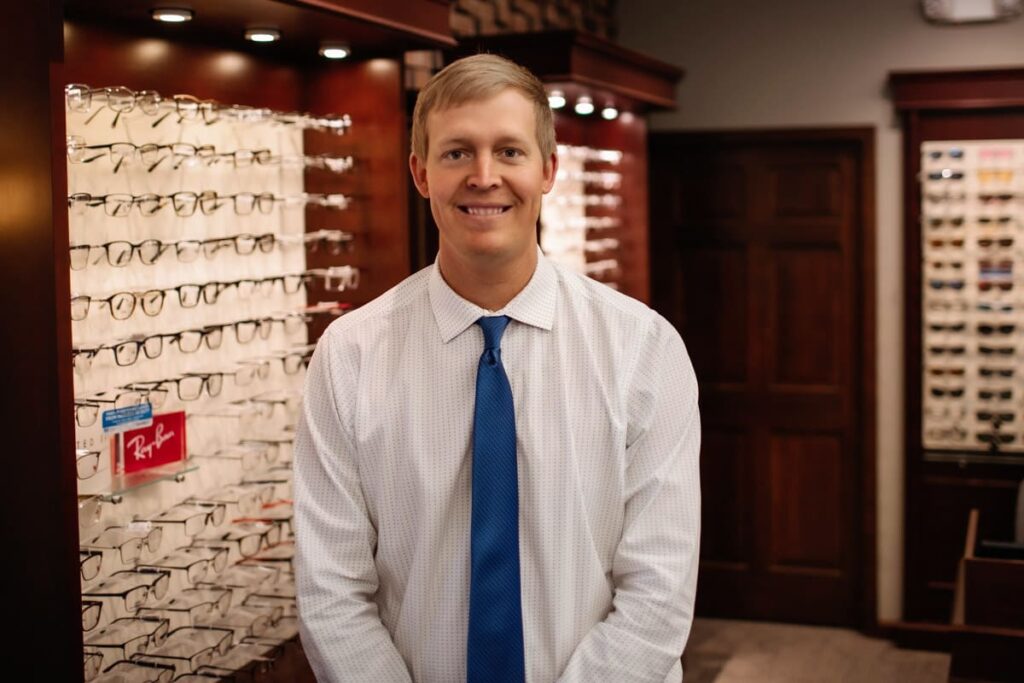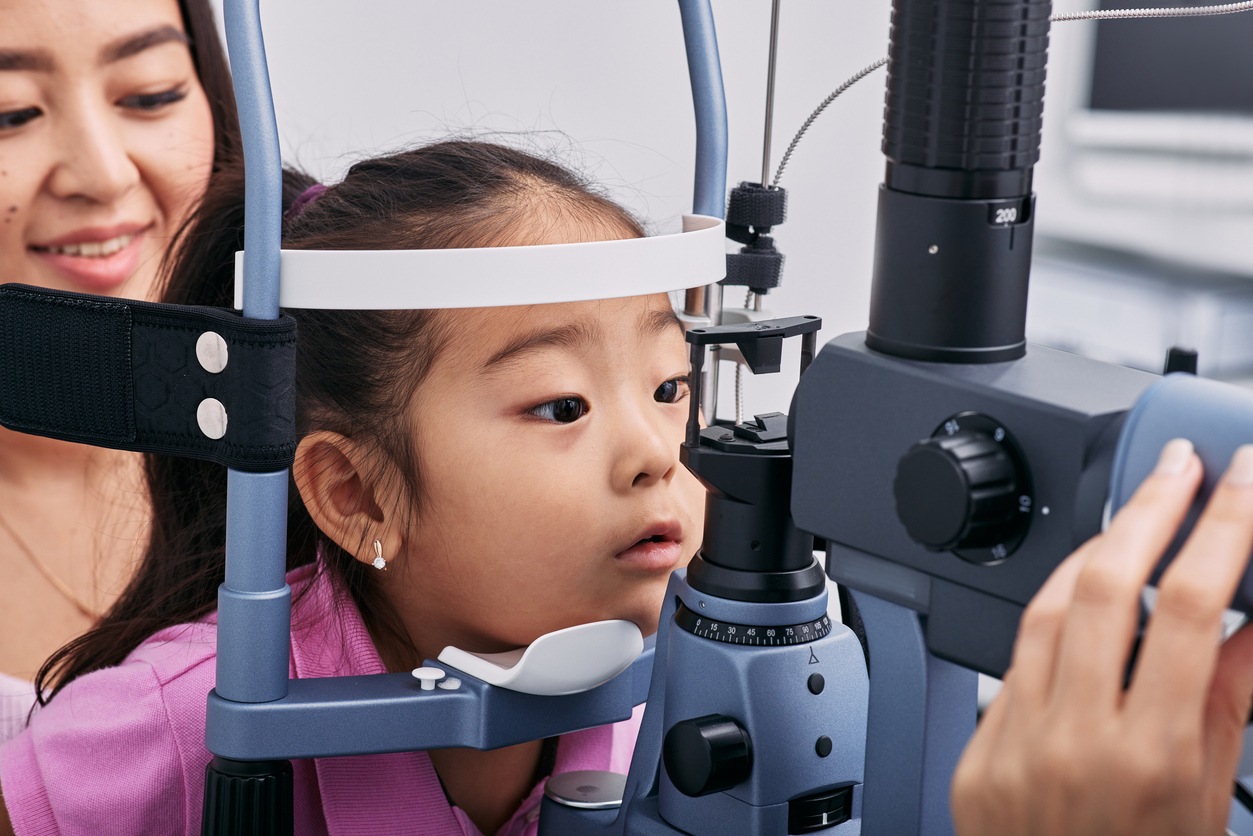You use your eyes on a daily basis for every aspect of your life. They…
What Are the Early Warning Signs of Macular Degeneration?

If cataracts are like looking through a pair of sunglasses that have fingerprint smudges on them, then macular degeneration is like wearing a pair of sunglasses with a slightly outdated prescription. As a bonus, the macular degeneration sunglasses are also smudged (but just a little bit), and they have a brand logo sticker stuck right in the center of one lens (but the sticker is clear so you can sort of try to ignore it if you’re determined enough).
Similar to cataracts, macular degeneration also tends to develop very gradually over time. It is usually first noticed by the patient in older age after significant vision loss—but it can be identified much earlier with regular comprehensive eye exams.
What Is Macular Degeneration?
As we age, the part of the eye called the macula takes damage. The macula is the round area at the center of your retina and is in charge of processing what you see right in front of you—it’s kind of a big deal.
The damage occurs as the light-sensitive cells in the macula break down slowly over a long period of time. The science is still unclear on exactly why this happens, but research indicates it is likely a combination of genetic and environmental factors, including things like diet and smoking.
Macular degeneration, also called age-related macular degeneration, is the leading cause of vision loss in older adults. There are two types of macular degeneration with different causes.
Dry Macular Degeneration
This is the most common type of macular degeneration, and it affects up to 90% of people with macular degeneration. It is caused by the accumulation of waste byproducts and photoreceptor debris that form under the thinning macula in the eye.
Oftentimes people who develop wet macular degeneration previously developed dry macular degeneration.
Wet Macular Degeneration
This type is far less common. It is caused when new blood vessels form under the retina. The new blood vessels can then leak fluids and blood, which disrupts the complex retinal anatomy of the eye, which often results in scarring.
Early Warning Signs
Dry macular degeneration symptoms typically develop very gradually over time and without any pain. Because macular degeneration can affect one or both eyes, it’s possible to have macular degeneration with no symptoms. Your healthier eye will compensate for visual distortions in the affected eye. This is your eyes’ superpower!
Also, since macular degeneration doesn’t affect side vision at all—it is located in the center of the visual field—it doesn’t cause total blindness, and that makes it easier to overlook (or intentionally ignore) for years or even decades.
The most obvious early warning sign to look for is a blurry spot, dark spot, or blind spot in the center of your field of vision. If you notice this, please schedule an appointment with an optometrist—we can help!
Early warning signs for dry macular degeneration may sound similar to the symptoms of cataracts: difficulty seeing in low light, trouble adapting to low light levels or light changes from bright to dim, colors looking faded, and blurred vision. The blurriness can be especially noticeable when reading printed words.
Early warning signs for wet macular degeneration are a little different: you could see straight geometric lines and structures in your environment (such as telephone poles, buildings, or billboards) appearing curved, crooked, or wavy; you may even begin to have difficulty recognizing faces.
With wet macular degeneration, it is more common to see the characteristic reduced central vision in one or both eyes during any time of day and in any lighting conditions. It is especially important to take action if you notice a well-defined dark spot in the center of your vision becoming progressively darker.

Treatment
The doctors at Andover & Winfield Family Optometry use the latest laser retinal scans to identify early signs of macular degeneration in our patients before starting them on high-level EyePromise Eye Vitamins. Wet macular degeneration can be treated with injections or photodynamic therapy, but outcomes are difficult to predict. We believe that early intervention and education provide our patients with the best chance for positive long-term outcomes.
Other ways to help slow the progression of both types of macular degeneration include wearing sunglasses more often (full time if possible), quitting smoking if you smoke, increasing the amount of vegetables in your diet (especially brightly colored and leafy green veggies), and taking steps to improve your overall health (get your primary healthcare provider on board!).
Is There a Test for Macular Degeneration?
Yes! Macular degeneration is a serious condition that should be identified as soon as possible for optimal treatment. The test we use at Andover & Winfield Family Optometry is called the MPOD.
That name sounds like something out of science fiction, but MPOD just stands for “macular pigment optical density.” Okay, we admit that it is a little bit like science fiction—in a cool way!—and we are so excited to be able to offer this technology to all our patients during a comprehensive eye exam.
https://ksfamilyoptometry.com/wp-content/uploads/2023/09/DAD386DD-C5D0-4AF0-9D43-E82083708081-1.mov
Doctor’s Recommendation
When it comes to macular degeneration—and any other health issue that can affect your vision—one of the most beneficial things you can do for your long-term eye health is get regular eye exams.
Regular eye exams are important for everyone, even if you don’t wear corrective lenses—and especially if any of the warning signs on this list are feeling a little too familiar. Comprehensive eye exams test your vision, along with several other important checks, to help keep you seeing your best.
If you live in Andover, Winfield, or east Wichita, KS, and you’re due (or overdue) for an eye exam, then we invite you to schedule an appointment with us!
Andover & Winfield Family Optometry offers comprehensive eye exams that go beyond a basic visual screening. We perform a series of visual acuity tests to make sure you’re seeing your best, and we also examine your eyes to identify early signs of health issues to facilitate early treatment and ensure your eye health stays at its best.
Call (316) 361-1020 for our Andover location or (620) 221-2015 for our Winfield location. We can’t wait to meet you!
About the Doctor
Dr. Matt Boswell was born and raised in Wichita, Kansas, where he graduated from Kapaun Mt. Carmel High School. He attended Emporia State University to play on the Men’s Basketball Team while getting his Bachelor of Science degree in Biology, Pre-Optometry. While there, Dr. Boswell made the academic honor roll every year while receiving all-league honors his senior year. After graduating from ESU, he went to Memphis, Tennessee, and received his Optometry Degree from the Southern College of Optometry in 2016. Dr. Boswell is excited to practice back in Andover and Winfield, where he was a patient of Dr. Holman’s growing up and shadowed him in high school.
Dr. Boswell’s areas of interest are comprehensive primary eye care and ocular disease, including glaucoma, macular degeneration, cataracts, and diabetes. He also loves fitting contact lenses and seeing kids. He is an active member of the American Optometric Association and the Kansas Optometric Association. Dr. Boswell resides in East Wichita with his wife, Kirsten, a nurse. They welcomed their first child in February 2022, Baker. They love the outdoors, playing sports, fishing, and staying active with their Bernese Mountain Dog, Franny.




